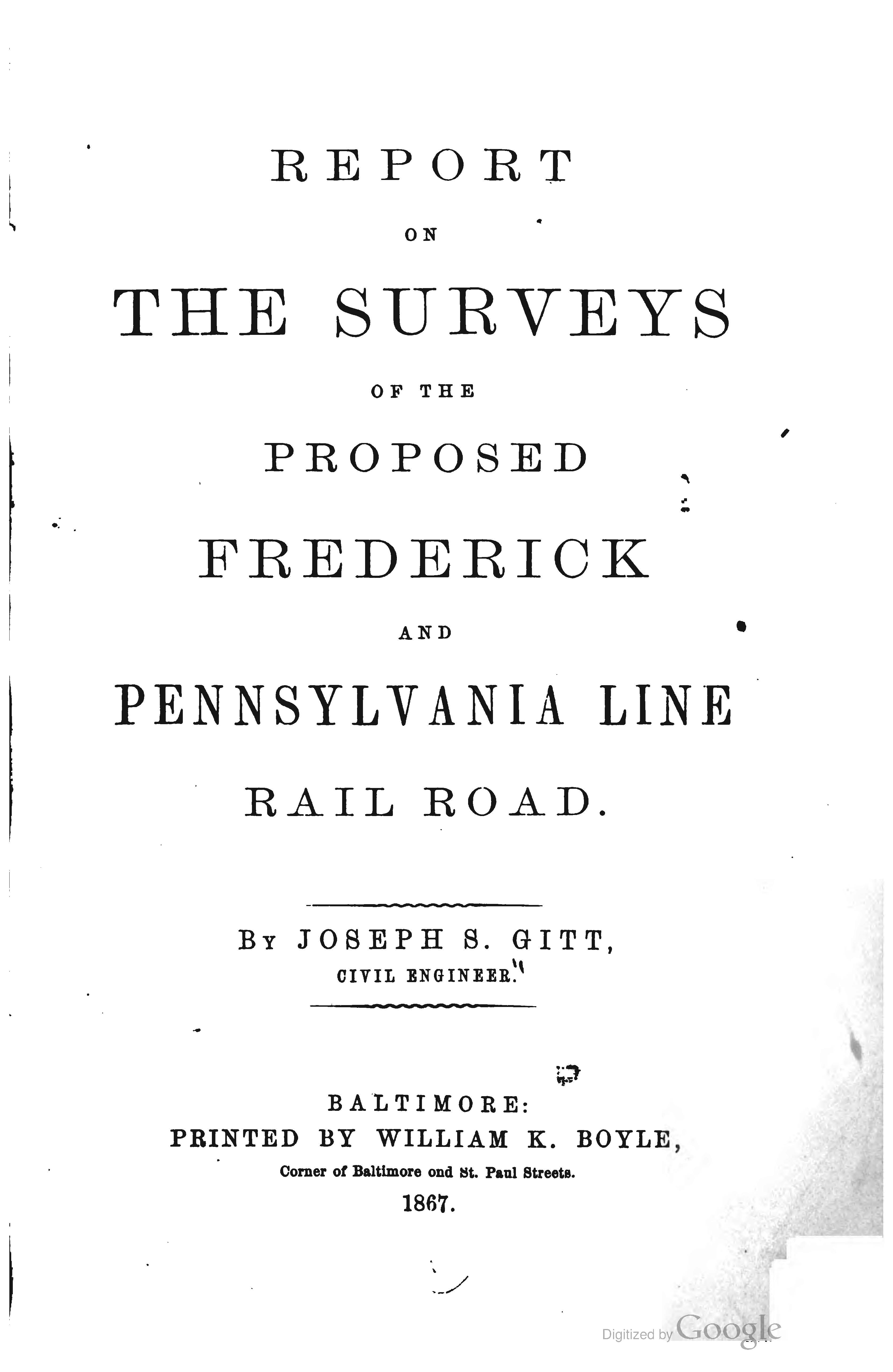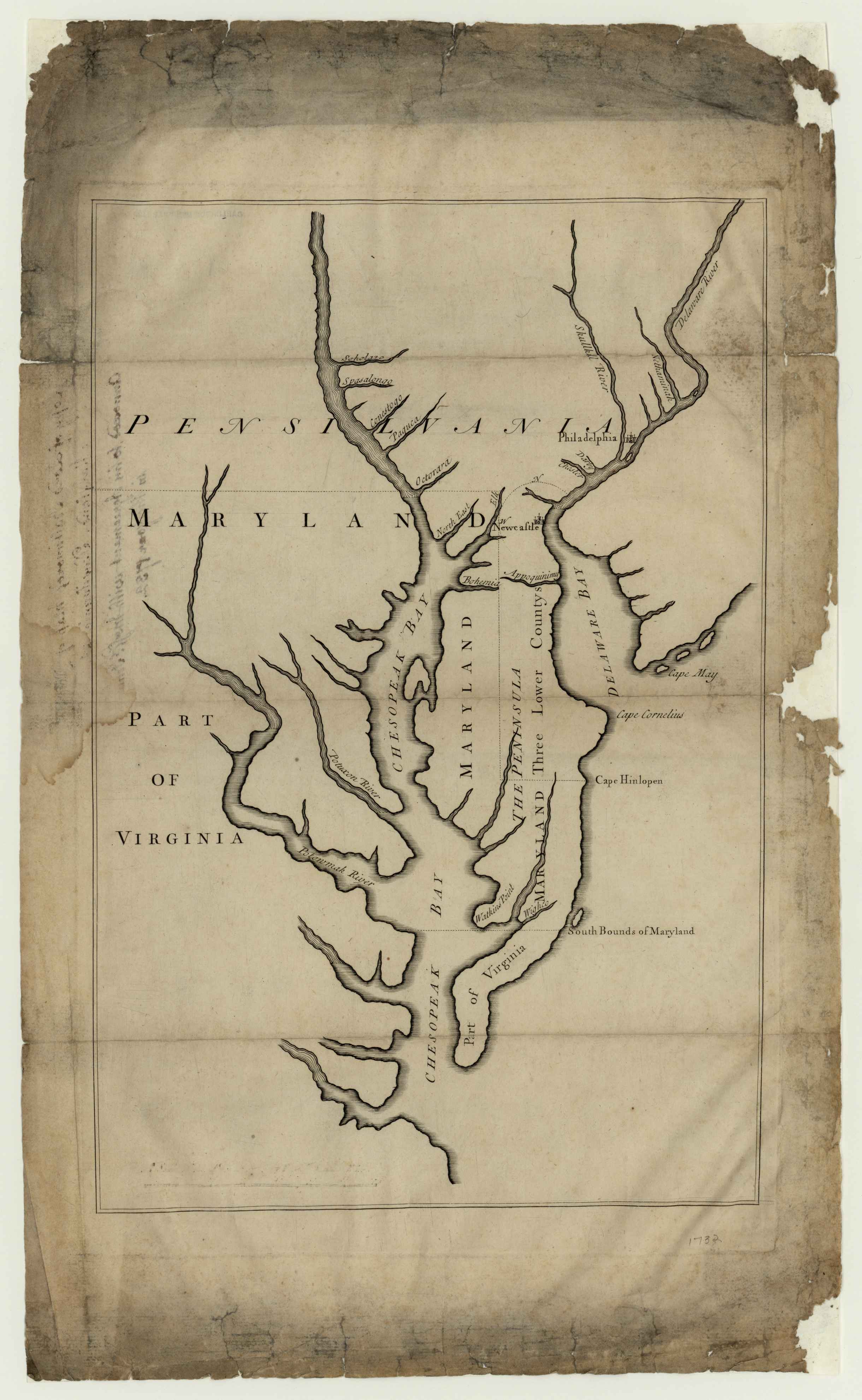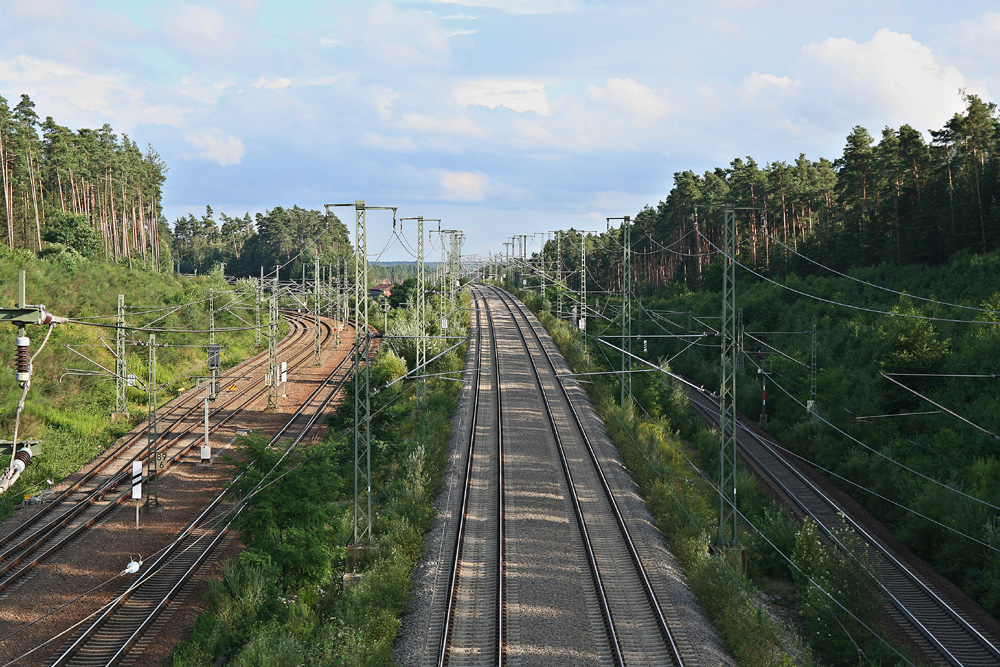|
Frederick And Pennsylvania Line Railroad Company
The Frederick and Pennsylvania Line railroad ran from Frederick, Maryland to the Pennsylvania-Maryland State line, or Mason–Dixon line near Kingsdale, Pennsylvania consisting of of center-line track and of total track including sidings. Chartered in 1867, the railroad started construction in 1869 and cost $868,687.50. It opened October 8, 1872 and was subsequently leased to the Pennsylvania Railroad (PRR) from January 1, 1875 and in July of that year, PRR formed the Frederick Division to operate the rail line. In the spring of 1896, it was Foreclosure sale#Strict foreclosure.2Fjudicial foreclosure, liquidated in a judicial sale to the PRR for 10 percent of its 1896 book value. Pennsylvania reorganized the railroad in December, 1896 as the Frederick and Northern Railroad Company. In March 1897, this new company was itself merged with other PRR-controlled railways, the Littlestown Railroad Company and the Hanover and York Railroad Company into the York, Hanover and Frederick Ra ... [...More Info...] [...Related Items...] OR: [Wikipedia] [Google] [Baidu] |
Maryland
Maryland ( ) is a U.S. state, state in the Mid-Atlantic (United States), Mid-Atlantic region of the United States. It borders the states of Virginia to its south, West Virginia to its west, Pennsylvania to its north, and Delaware to its east, as well as with the Atlantic Ocean to its east, and the national capital and federal district of Washington, D.C. to the southwest. With a total area of , Maryland is the List of U.S. states and territories by area, ninth-smallest state by land area, and its population of 6,177,224 ranks it the List of U.S. states and territories by population, 18th-most populous state and the List of states and territories of the United States by population density, fifth-most densely populated. Maryland's capital city is Annapolis, Maryland, Annapolis, and the state's most populous city is Baltimore. Maryland's coastline was first explored by Europeans in the 16th century. Prior to that, it was inhabited by several Native Americans in the United States ... [...More Info...] [...Related Items...] OR: [Wikipedia] [Google] [Baidu] |
Walkersville, Maryland
Walkersville is a town in Frederick County, Maryland, United States. The population was 5,800 at the 2010 census. History Crum Road Bridge was listed on the National Register of Historic Places in 1978. The Woodsboro and Frederick Turnpike Company Tollhouse was listed in 1979 and Harris Farm in 1994. Geography According to the United States Census Bureau, the town has a total area of , of which is land and is water. Transportation The primary method of travel to and from Walkersville is by road. Maryland Route 194 is the only significant highway serving the town. MD 194 traverses the region southwest-to-northeast, providing connections to Maryland Route 26 and the Frederick area to the south, and to Woodsboro and Taneytown to the north. Demographics The median income for a household in the town was $65,581, and the median income for a family was $69,476. Males had a median income of $47,309 versus $31,817 for females. The per capita income for the town was $24,103 ... [...More Info...] [...Related Items...] OR: [Wikipedia] [Google] [Baidu] |
List Of Turnpikes In Maryland
Maryland’s first road statute, the 1666 ''Act for Making High Wayes'', directed each county court to select, clear, and maintain “highways,” funding the work through compulsory labor or tobacco levies. The 1696 ''Act for the Better Clearing of the Roads'' reaffirmed those obligations but still provided no dedicated cash revenue. As overland commerce expanded after the Revolution, the General Assembly in 1787 authorized tolled, 66-foot-wide roads from Baltimore toward Frederick, Reisterstown (with branches to Westminster and Hanover), and York, prescribing surfacing standards and gate spacing while leaving construction to county commissioners. That hybrid public-oversight/toll-revenue model became the legal framework for the chartered turnpike companies listed below. The Monocacy Road and Nemacolin's Path were Indigenous thoroughfares later adapted for colonial traffic. The Monocacy was widened for wagons by 1739. It linked the Potomac crossing at Conococheague Creek w ... [...More Info...] [...Related Items...] OR: [Wikipedia] [Google] [Baidu] |
Joseph S
Joseph is a common male name, derived from the Hebrew (). "Joseph" is used, along with " Josef", mostly in English, French and partially German languages. This spelling is also found as a variant in the languages of the modern-day Nordic countries. In Portuguese and Spanish, the name is "José". In Arabic, including in the Quran, the name is spelled , . In Kurdish (''Kurdî''), the name is , Persian, the name is , and in Turkish it is . In Pashto the name is spelled ''Esaf'' (ايسپ) and in Malayalam it is spelled ''Ousep'' (ഔസേപ്പ്). In Tamil, it is spelled as ''Yosepu'' (யோசேப்பு). The name has enjoyed significant popularity in its many forms in numerous countries, and ''Joseph'' was one of the two names, along with ''Robert'', to have remained in the top 10 boys' names list in the US from 1925 to 1972. It is especially common in contemporary Israel, as either "Yossi" or "Yossef", and in Italy, where the name "Giuseppe" was the most commo ... [...More Info...] [...Related Items...] OR: [Wikipedia] [Google] [Baidu] |
Pages From 1867 Gitt Survey For Frederick And Pennsylvania Line RR Cover Page
Page most commonly refers to: * Page (paper), one side of a leaf of paper, as in a book Page, PAGE, pages, or paging may also refer to: Roles * Page (assistance occupation), a professional occupation * Page (servant), traditionally a young male servant * Page (wedding attendant) People and fictional characters * Page (given name), a list of people * Page (surname), a list of people and fictional characters * Pages (surname) * H. A. Page, a pen name of Scottish author Alexander Hay Japp (1836–1905) Places Australia * Page, Australian Capital Territory, a suburb of Canberra * Division of Page, New South Wales * Pages River, a tributary of the Hunter River catchment in New South Wales, Australia * The Pages, South Australia, two islands and a reef **The Pages Conservation Park, a protected area in South Australia United States * Page, Arizona, a city * Page, Indiana * Page, Minneapolis, Minnesota, a neighborhood * Page, Nebraska, a village * Page, North Dakota, a city * Page, ... [...More Info...] [...Related Items...] OR: [Wikipedia] [Google] [Baidu] |
Air-line Railroad
An air-line railroad was a railroad that was relatively straight, following a shorter (and thus, presumably quicker) route instead of a longer, winding route. In their heyday, which was prior to aviation, they were often referred to simply as "air lines". Dictionary definition Webster's Dictionary#1913 edition, Webster's 1913 dictionary gives the definition "Air line, a straight line; a bee line. Hence Air-line, adj.; as, air-line road." Public reaction Air line railroads began to be built in the mid-nineteenth century. As early as 1853, the ''New York Daily Times'' ran a satirical article mocking the trend, suggesting that the fad for an "air line" name was being used to float dubious investments: :The "air-line" is three miles and nine-thirteenths shorter from Quattlebum to Squashtown than the present traveled route by the Conger Creek railroad.... Though we know there is already a railroad in operation between Quattlebum and Squash Town, parallel with and not far from our air ... [...More Info...] [...Related Items...] OR: [Wikipedia] [Google] [Baidu] |
Train Station
A train station, railroad station, or railway station is a railway facility where trains stop to load or unload passengers, freight, or both. It generally consists of at least one platform, one track, and a station building providing such ancillary services as ticket sales, waiting rooms, and baggage/freight service. Stations on a single-track line often have a passing loop to accommodate trains travelling in the opposite direction. Locations at which passengers only occasionally board or leave a train, sometimes consisting of a short platform and a waiting area but sometimes indicated by no more than a sign, are variously referred to as "stops", " flag stops", " halts", or "provisional stopping places". The stations themselves may be at ground level, underground, or elevated. Connections may be available to intersecting rail lines or other transport modes such as buses, trams, or other rapid transit systems. Terminology ''Train station'' is the terminology typic ... [...More Info...] [...Related Items...] OR: [Wikipedia] [Google] [Baidu] |
Railway Terminal
A train station, railroad station, or railway station is a railway facility where trains stop to load or unload passengers, freight, or both. It generally consists of at least one platform, one track, and a station building providing such ancillary services as ticket sales, waiting rooms, and baggage/freight service. Stations on a single-track line often have a passing loop to accommodate trains travelling in the opposite direction. Locations at which passengers only occasionally board or leave a train, sometimes consisting of a short platform and a waiting area but sometimes indicated by no more than a sign, are variously referred to as "stops", "flag stops", " halts", or "provisional stopping places". The stations themselves may be at ground level, underground, or elevated. Connections may be available to intersecting rail lines or other transport modes such as buses, trams, or other rapid transit systems. Terminology ''Train station'' is the terminology typically us ... [...More Info...] [...Related Items...] OR: [Wikipedia] [Google] [Baidu] |
Branch Lines
A branch line is a secondary railway line which branches off a more important through route, usually a main line. A very short branch line may be called a spur line. Branch lines may serve one or more industries, or a city or town not located on a main line. Branch lines may also connect two or more main lines. Industrial spur An industrial spur is a type of secondary track used by railroads to allow customers at a location to load and unload railcars without interfering with other railroad operations. Industrial spurs can vary greatly in length and railcar capacity depending on the requirements of the customer the spur is serving. In heavily industrialized areas, it is not uncommon for one industrial spur to have multiple sidings to several different customers. Typically, spurs are serviced by local trains responsible for collecting small numbers of railcars and delivering them to a larger yard, where these railcars are sorted and dispatched in larger trains with othe ... [...More Info...] [...Related Items...] OR: [Wikipedia] [Google] [Baidu] |
Main Line (railway)
The main line, or mainline in American English, of a railway is a track that is used for through trains or is the principal artery of the system from which branch lines, yards, sidings, and spurs are connected. It generally refers to a route between towns, as opposed to a route providing suburban or metro services. It may also be called a trunk line, for example the Grand Trunk Railway The Grand Trunk Railway (; ) was a Rail transport, railway system that operated in the Provinces and territories of Canada, Canadian provinces of Quebec and Ontario and in the List of states and territories of the United States, American sta ... in Canada, or the Trunk Line in Norway. For capacity reasons, main lines in many countries have at least a double track and often contain multiple parallel tracks. Main line tracks are typically operated at higher speeds than branch lines and are generally built and maintained to a higher standard than yards and branch lines. Main lines may als ... [...More Info...] [...Related Items...] OR: [Wikipedia] [Google] [Baidu] |
First Transcontinental Railroad
America's first transcontinental railroad (known originally as the "Pacific Railroad" and later as the "Overland Route (Union Pacific Railroad), Overland Route") was a continuous railroad line built between 1863 and 1869 that connected the existing eastern U.S. rail network at Council Bluffs, Iowa, with the Pacific coast at the Oakland Long Wharf on San Francisco Bay. The rail line was built by three private companies over public lands provided by extensive Land grant#Public lands and bounty-land warrants, U.S. land grants.Pacific Railroad Act of 1862, §2 & §3 Building was financed by both state and U.S. government subsidy bonds as well as by company-issued mortgage bonds.Pacific Railroad Act of 1862, §5 & §6 The Western Pacific Railroad (1862–1870), Western Pacific Railroad Company built of track from the road's western terminus at Alameda, California, Alameda/Oakland, California, Oakland to Sacramento, California. The Central Pacific Railroad, Central Pacific Railroad Co ... [...More Info...] [...Related Items...] OR: [Wikipedia] [Google] [Baidu] |
Cast Iron
Cast iron is a class of iron–carbon alloys with a carbon content of more than 2% and silicon content around 1–3%. Its usefulness derives from its relatively low melting temperature. The alloying elements determine the form in which its carbon appears: Cast iron#White cast iron, white cast iron has its carbon combined into an iron carbide named cementite, which is very hard, but brittle, as it allows cracks to pass straight through; Grey iron, grey cast iron has graphite flakes which deflect a passing crack and initiate countless new cracks as the material breaks, and Ductile iron, ductile cast iron has spherical graphite "nodules" which stop the crack from further progressing. Carbon (C), ranging from 1.8 to 4 wt%, and silicon (Si), 1–3 wt%, are the main alloying elements of cast iron. Iron alloys with lower carbon content are known as steel. Cast iron tends to be brittle, except for malleable iron, malleable cast irons. With its relatively low melting point, g ... [...More Info...] [...Related Items...] OR: [Wikipedia] [Google] [Baidu] |







